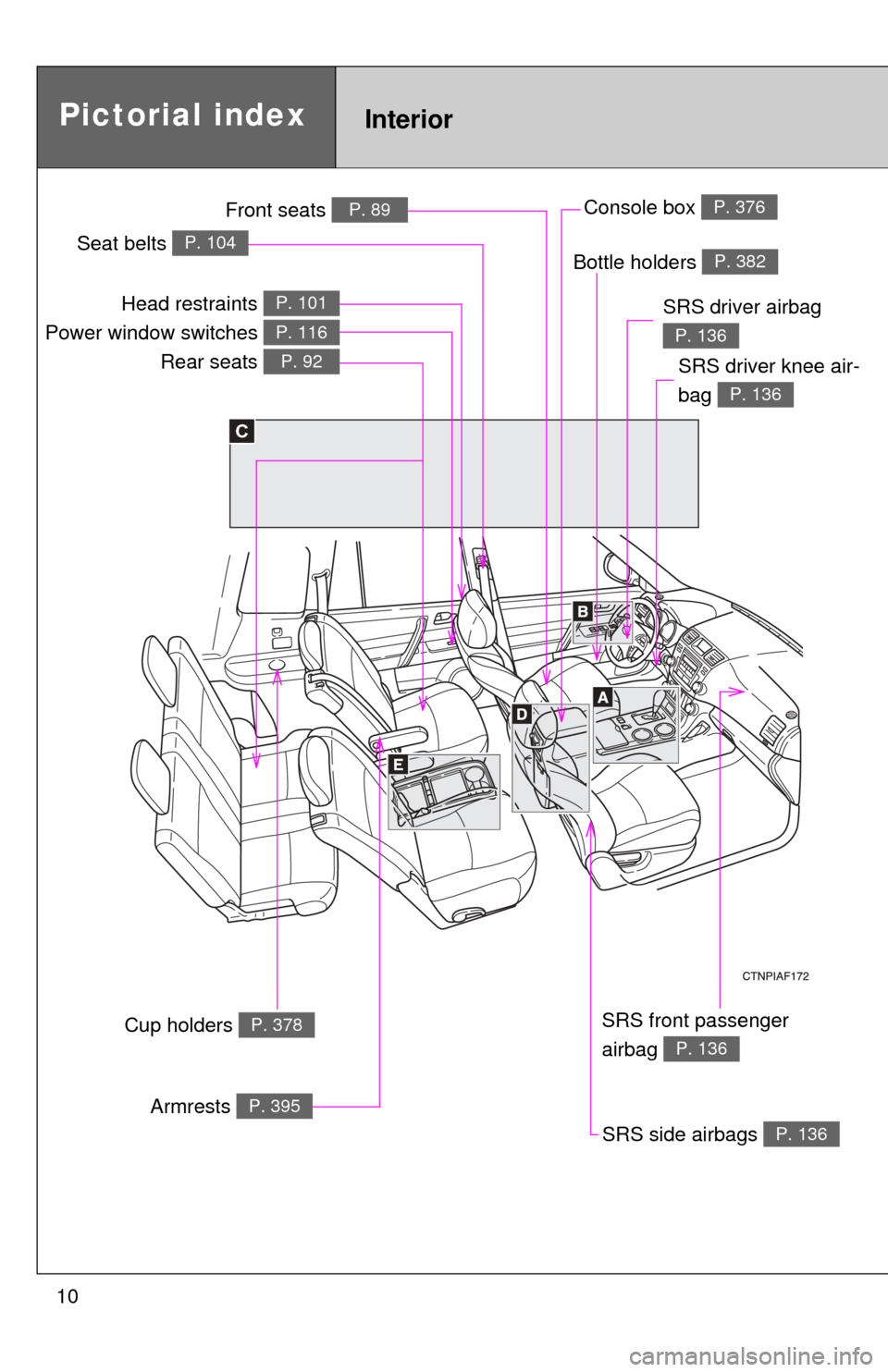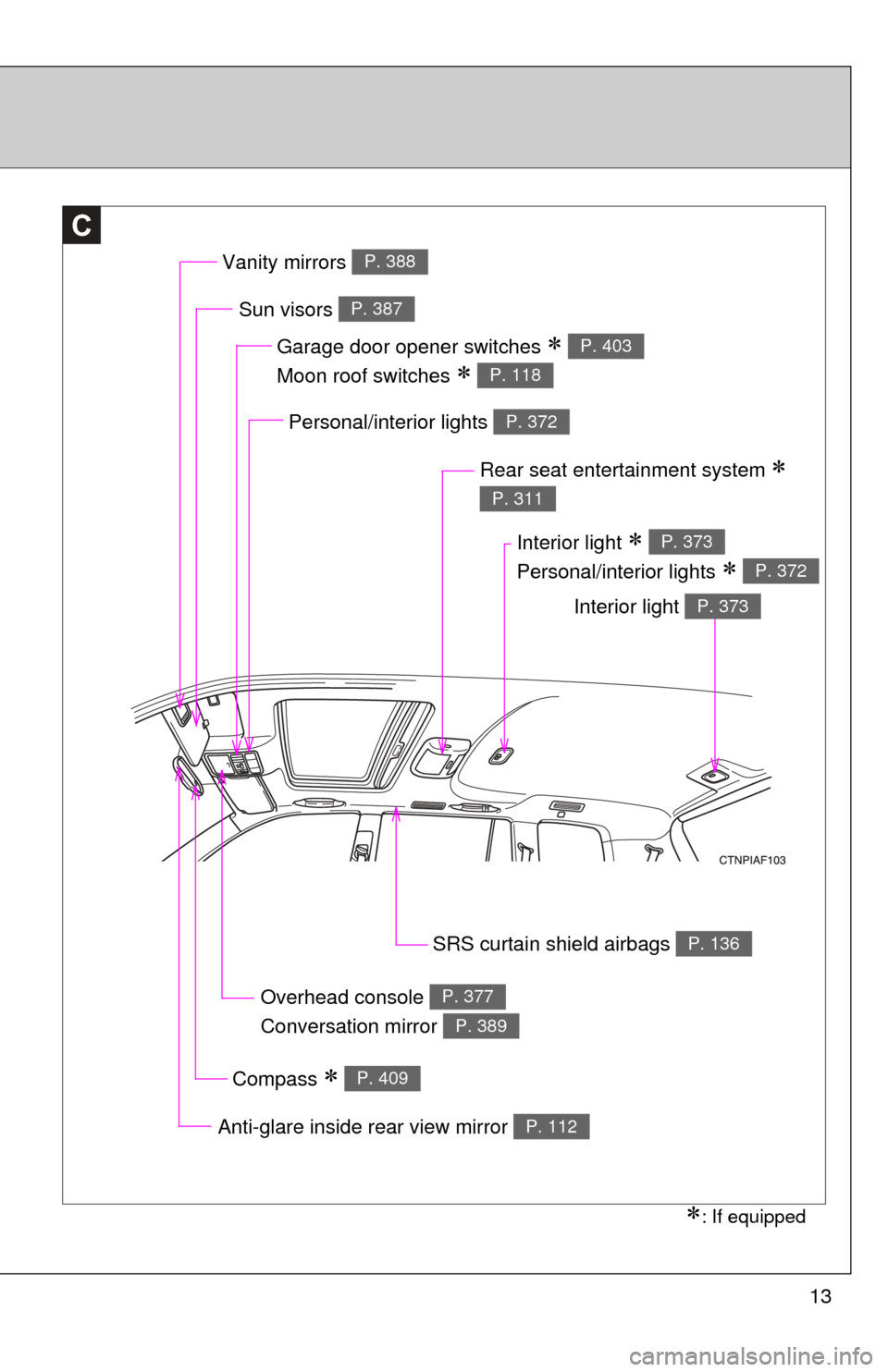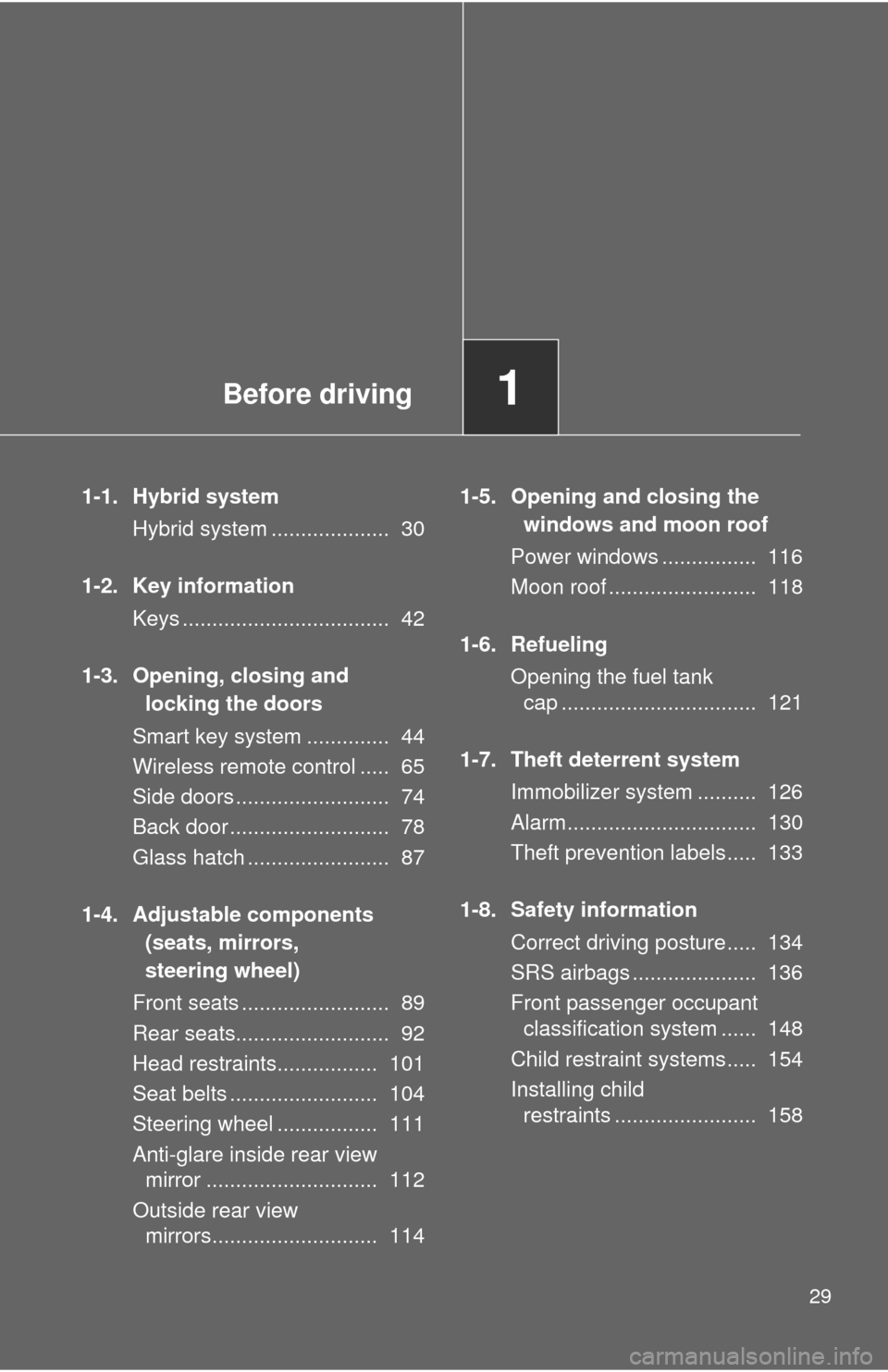airbag TOYOTA HIGHLANDER HYBRID 2010 XU40 / 2.G Owners Manual
[x] Cancel search | Manufacturer: TOYOTA, Model Year: 2010, Model line: HIGHLANDER HYBRID, Model: TOYOTA HIGHLANDER HYBRID 2010 XU40 / 2.GPages: 592, PDF Size: 12 MB
Page 2 of 592

TABLE OF CONTENTSIndex
2
1-1. Hybrid systemHybrid system ...................... 30
1-2. Key information Keys ..................................... 42
1-3. Opening, closing and locking the doors
Smart key system................. 44
Wireless remote control ....... 65
Side doors ............................ 74
Back door ............................. 78
Glass hatch .......................... 87
1-4. Adjustable components (seats, mirrors,
steering wheel)
Front seats ........................... 89
Rear seats ............................ 92
Head restraints ................... 101
Seat belts ........................... 104
Steering wheel ................... 111
Anti-glare inside rear view mirror ................................ 112
Outside rear view mirrors ... 114
1-5. Opening and closing the windows and moon roof
Power windows .................. 116
Moon roof ........................... 118 1-6. Refueling
Opening the fuel tank cap .................................... 121
1-7. Theft deterrent system Immobilizer system ............. 126
Alarm .................................. 130
Theft prevention labels ....... 133
1-8. Safety information Correct driving posture ....... 134
SRS airbags ....................... 136
Front passenger occupant classification system ......... 148
Child restraint systems ....... 154
Installing child restraints ..... 158
2-1. Driving procedures Driving the vehicle .............. 170
Power (ignition) switch........ 180
EV-Drive Mode ................... 184
Transmission ...................... 186
Turn signal lever ................. 188
Parking brake ..................... 189
Horn .................................... 190
1Before driving
2When driving
Page 10 of 592

10
SRS side airbags P. 136
Console box P. 376
C
Cup holders P. 378
Armrests P. 395
SRS front passenger
airbag
P. 136
Seat belts P. 104
Front seats P. 89
Bottle holders P. 382
SRS driver airbag
P. 136
SRS driver knee air-
bag
P. 136
Head restraints
Power window switches Rear seats P. 101
P. 116
P. 92
Pictorial indexInterior
Page 13 of 592

13
C
Overhead console
Conversation mirror P. 377
P. 389
Garage door opener switches
Moon roof switches
P. 403
P. 118
Sun visors P. 387
Personal/interior lights P. 372
Rear seat entertainment system
P. 311
SRS curtain shield airbags P. 136
Compass P. 409
Anti-glare inside rear view mirror P. 112
: If equipped
Vanity mirrors P. 388
Interior light
Personal/interior lights
P. 373
P. 372
Interior light P. 373
Page 25 of 592

25
Installation of a mobile two-way radio system
As the installation of a mobile two-way radio system in your vehicle may
affect electronic systems such as the multi-port fuel injection system/sequen-
tial multi-port fuel injection system, cruise control system, anti-lock brake
system, SRS airbag system or seat belt pretensioner system, be sure to
check with your Toyota dealer for precautionary measures or special instruc-
tions regarding installation.
High voltage parts and cables on the hybrid vehicles emit approximately the
same amount of electromagnetic waves as the conventional gasoline pow-
ered vehicles or home electronic appliances despite of their electromagnetic
shielding.
Unwanted noise may occur in the reception of the mobile two-way radio.
Scrapping of your Toyota
The SRS airbag and seat belt pretensioner devices in your Toyota contain
explosive chemicals. If the vehicle is scrapped with the airbags and seat belt
pretensioners left as they are, this may cause an accident such as fire. Be
sure to have the systems of the SRS airbag and seat belt pretensioner
removed and disposed of by a qualified service shop or by your Toyota
dealer before you scrap your vehicle.
Perchlorate Material
Special handling may apply, See www.dtsc.ca.gov/hazardouswaste/perchlorate.
Your vehicle has components that may contain perchlorate. These compo-
nents may include airbag, seat belt pretensioners, and wireless remote con-
trol batteries.
Page 29 of 592

Before driving1
29
1-1. Hybrid systemHybrid system .................... 30
1-2. Key information Keys ................................... 42
1-3. Opening, closing and locking the doors
Smart key system .............. 44
Wireless remote control ..... 65
Side doors .......................... 74
Back door ........................... 78
Glass hatch ........................ 87
1-4. Adjustable components (seats, mirrors,
steering wheel)
Front seats ......................... 89
Rear seats.......................... 92
Head restraints................. 101
Seat belts ......................... 104
Steering wheel ................. 111
Anti-glare inside rear view mirror ............................. 112
Outside rear view mirrors............................ 114 1-5. Opening and closing the
windows and moon roof
Power windows ................ 116
Moon roof ......................... 118
1-6. Refueling Opening the fuel tank cap ................................. 121
1-7. Theft deterrent system Immobilizer system .......... 126
Alarm................................ 130
Theft prevention labels..... 133
1-8. Safety information Correct driving posture..... 134
SRS airbags ..................... 136
Front passenger occupant classification system ...... 148
Child restraint systems..... 154
Installing child restraints ........................ 158
Page 136 of 592

136
1-8. Safety information
SRS airbags
The SRS airbags inflate when the vehicle is subjected to certain
types of severe impacts that may cause significant injury to the
occupants. They work together with the seat belts to help reduce the
risk of death or serious injury.
Front airbags
Driver airbag/front passenger airbag
Can help protect the head and ches t of the driver and front pas-
senger from impact with interior components.
Driver knee airbag
Can help provide driver protection.
Side and curtain shield airbags
Side airbags
Can help protect the torso of the front seat occupants.
Curtain shield airbags
Can help protect primarily the head of outside occupants.
Page 137 of 592

137
1-8. Safety information
1
Before driving
Airbag system components
Your vehicle is equipped with ADVANCED AIRBAGS designed based
on US motor vehicle safety standards (FMVSS208). The airbag sys-
tem controls airbag deployment po wer for the driver and front pas-
senger. The driver airbag system cons ists of the driver seat's position
sensor etc. The front passenger's ai rbag system consists of the front
passenger occupant classification sensor etc. Curtain shield airbags
Side airbags
Front passenger airbag
Side and curtain shield air-
bag sensors
Front airbag sensors
Front passenger’s seat belt
buckle switch
Curtain shield airbag sen-
sors
“AIR BAG ON” and “AIR
BAG OFF” indicator lights
SRS warning light
Driver airbag
Driver’s seat position sen-
sor
Driver’s seat belt buckle
switch
Driver knee airbag
Airbag sensor assembly
Occupant detection system
(ECU and sensors)
Page 138 of 592

138 1-8. Safety information
The main SRS airbag system components are shown above. The
SRS airbag system is controlled by the airbag sensor assembly. The
airbag sensor assembly consists of a safing sensor and an airbag
sensor.
In certain types of severe frontal or side impacts, the SRS airbag sys-
tem triggers the airbag inflators. A chemical reaction in the inflators
quickly fills the airbags with non-toxic gas to help restrain the motion
of the occupants.
■ SRS warning light
This warning light system monitors the airbag sensor assembly, front airbag
sensors, side and curtain shield airbag sensor assemblies, curtain shield air-
bag sensor assemblies, driver's seat position sensor, driver's seat belt
buckle switch, front passenger occupant classification system, “AIR BAG
ON” and “AIR BAG OFF” indicator lights, front passenger’s seat belt buckle
switch, front seat belt pretensioner assemblies, inflators, interconnecting wir-
ing and power sources. ( P. 503)
■ If the SRS airbags deploy (inflate)
●Bruising and slight abrasions may result from contact with a deploying
(inflating) SRS airbag.
● A loud noise and white powder will be emitted.
● Parts of the airbag module (steering wheel hub, airbag cover and inflator)
as well as the front seats, and parts of the front and rear pillars and roof
side rail, may be hot for several minutes. The airbag itself may also be
hot.
● The windshield may crack.
Page 139 of 592

139
1-8. Safety information
1
Before driving
■
SRS airbag deployment conditions (front airbags)
●The front SRS airbags will deploy in the event of an impact that exceeds
the set threshold level (the level of force corresponding to a 12 - 18 \
mph
[20 - 30 km/h] frontal collision with a fixed wall that does not move or
deform).
However, this threshold velocity will be considerably higher if the vehicle
strikes an object, such as a parked vehicle or sign pole, which can move or
deform on impact, or if the vehicle is involved in an underride collision (e.g.
a collision in which the front of the vehicle “underrides”, or goes under, the
bed of a truck, etc.).
● It is possible that in some collisions where the forward deceleration of the
vehicle is very close to the designed threshold level, the SRS front air-
bags and the seat belt pretensioners may not activate together.
● The SRS front passenger airbag will not activate if there is no passenger
sitting in the front passenger seat. However, the front passenger airbag
may deploy if luggage is put in the seat, or the seat belt is fastened, even
if the seat is unoccupied. ( P. 148)
■ SRS airbag deployment conditions (SRS side airbags)
●The SRS side airbags will deploy in the event of an impact that exceeds
the set threshold level (the level of force corresponding to the impact
force produced by a 3300 lb. [1500 kg] vehicle colliding with the vehicle
cabin from a direction perpendicular to the vehicle orientation at a speed
of 12 - 18 mph [20 - 30 km/h]).
● The SRS side airbag on the passenger seat will not activate if there is no
passenger sitting in the front passenger seat. However, the side airbag
on the passenger seat may deploy if luggage is put in the seat, or the
seat belt is fastened, even if the seat is unoccupied. ( P. 148)
■ SRS airbag deployment conditions (SRS curtain shield airbags)
The SRS curtain shield airbags will deploy in the event of vehicle rollover or
an impact that exceeds the set threshold level (the level of force correspond-
ing to the impact force produced by a 3300 lb. [1500 kg] vehicle colliding with
the vehicle cabin from a direction perpendicular to the vehicle orientation at
a speed of 12 - 18 mph [20 - 30 km/h]).
Page 140 of 592

140 1-8. Safety information
■Conditions under which the SRS airbags may deploy (inflate), other
than a collision
The SRS front airbags may also deploy if a serious impact occurs to the
underside of your vehicle. Some examples are shown in the illustration.
The SRS curtain shield airbags may also deploy under the situation shown
in the illustration.
■ Types of collisions that may not depl oy the SRS airbag (front airbags)
The SRS front airbags are generally not designed to inflate if the vehicle is
involved in a side or rear collision, if it rolls over, or if it is involved in a low-
speed frontal collision. But, whenever a collision of any type causes suffi-
cient forward deceleration of the vehicle, deployment of the SRS front air-
bags may occur.
● Hitting a curb, edge of pavement or
hard surface
● Falling into or jumping over a deep hole
● Landing hard or vehicle falling
●The angle of vehicle tip-up is marginal.
● The vehicle skids and hits a curb stone.
●Collision from the side
● Collision from the rear
● Vehicle rollover